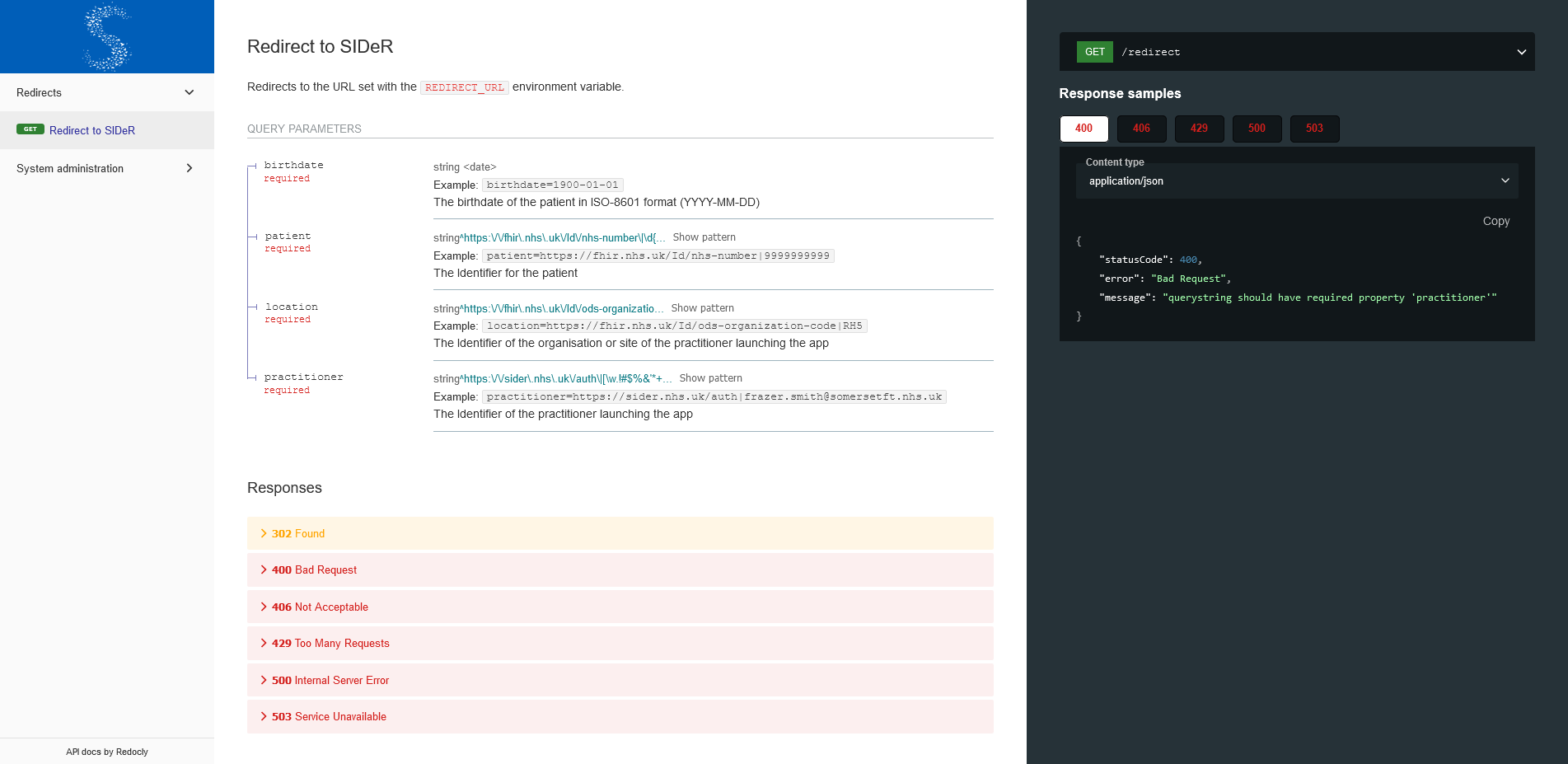Note This repository is unmaintained as of 2023-05-03 as I am no longer employed by Somerset NHS Foundation Trust.

Yeovil Hospital's SIDeR contextual link obfuscation service
This is Yeovil Hospital's SIDeR contextual link obfuscation service, a Node.js application using the Fastify web framework and Black Pear's obfuscated-querystring.
This service was created out of a need for query string parameters containing personally identifiable data to be obfuscated when users click on the SIDeR contextual link within Yeovil Hospital's Patient Administration System (PAS), InterSystems TrakCare.
A video demonstrating the contextual link in action can be found here.
Single sign-on for a user using access tokens from a Keycloak server instance, and query string API key auth, can be enabled using environment variables found in .env.template.
These are only required if running the API outside of Docker:
- Node.js >=18.12.1
Perform the following steps before deployment:
- Download and extract the latest release asset
- Navigate to the extracted directory
- Make a copy of
.env.templatein the root directory and rename it to.env - Configure the application using the environment variables in
.env
Note Set the following environment variables in
.envto meet NHS England's recommendation to retain six months' worth of logs:
LOG_ROTATION_DATE_FORMAT="YYYY-MM-DD"LOG_ROTATION_FREQUENCY="daily"LOG_ROTATION_MAX_LOGS="180d"
- Run
npm ci --ignore-scripts --omit=devto install dependencies - Run
npm start
The service should now be up and running on the port set in the config. Output similar to the following should appear in stdout or in the log file specified using the LOG_ROTATION_FILENAME environment variable:
{
"level": "info",
"time": "2022-10-24T09:07:09.513Z",
"pid": 25212,
"hostname": "MYCOMPUTER",
"msg": "Server listening at http://127.0.0.1:49217"
}To test it, use Insomnia and import the example requests from ./test_resources/insomnia_test_requests.json.
This requires Docker installed.
- Run
docker compose up(ordocker compose up -dto run in the background)
If this cannot be deployed into production using Docker, use a process manager such as PM2.
- Run
npm ci --ignore-scripts --omit=devto install dependencies - Run
npm i -g pm2to install pm2 globally - Launch the application with
pm2 start .pm2.config.js - Check that the application has been deployed using
pm2 listorpm2 monit
If using a Microsoft Windows OS utilise pm2-installer to install PM2 as a Windows service.
Note PM2 will automatically restart the application if
.envis modified.
API documentation can be found at /docs:
The underlying OpenAPI definitions are found at /docs/openapi.
This section is for members of the Solutions Development and Application Support teams at Yeovil Hospital, or other NHS Trusts that use InterSystems TrakCare as their PAS.
To adhere to Black Pear/NHS Somerset ICB's contextual launch specification, the SIDeR contextual link's icon profile values in TrakCare must be set to the following:
Link URL: <obfuscation service path>/redirect
Link expression: "&"_##class(Custom.ENYH.Integration.ContextualLink.GenericPatientLink).BuildURLVars("patient=https://fhir.nhs.uk/Id/nhs-number|{NHSNumber}&birthdate={DateOfBirthISO8601}&location=https://fhir.nhs.uk/Id/ods-organization-code|RH5&practitioner=https://sider.nhs.uk/auth|{UserName}@somersetft.nhs.uk")
If query string auth is enabled using the QUERY_STRING_API_KEY_ARRAY environment variable, the link expression will need to include the api_key query string param with a valid API key.
The icon itself can be found in the root of the images folder.
Contributions are welcome, and any help is greatly appreciated!
See the contributing guide for details on how to get started. Please adhere to this project's Code of Conduct when contributing.
- Anthony Smith (Chief Clinical Information Officer) - Contextual link logo design
- David Suckling (Application Support Manager) - Contextual link implementation and testing
- Mark Hunt - Keycloak single sign-on access tokens integration and testing
- Will Jehring - Query string obfuscation, redirect testing, and Keycloak testing
yh-sider-obfuscation-service is licensed under the MIT license.




